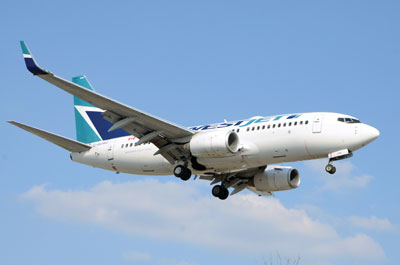
Features
Operations
Winning the emissions game
Canada’s aviation industry and the federal government have agreed upon a plan of action to reduce CO2 emissions by a minimum two per cent a year to 2020.
July 10, 2012 By David Carr
Canada’s aviation industry and the federal government have agreed upon a plan of action to reduce CO2 emissions by a minimum two per cent a year to 2020. Canada’s Action Plan to Reduce GHG Emissions from Aviation freezes a commitment to the International Civil Aviation Organization’s (ICAO) 2010 voluntary global reduction goals by complying with a request by the organization that member states submit detailed plans on how they plan to hit target by June 2012.
 |
|
| The transport sector runs neck and neck with oil and gas as the largest source of greenhouse gas (GHG) emissions. In 2008, air transport alone accounted for five per cent or 8.5 million metric tonnes. Canadian airlines such as WestJet will need to work harder in the months and years ahead to reduce their emissions footprint. PHOTO: Brian McNair
|
The action plan identifies three key measures that are expected to have the greatest impact:
- Aircraft fleet renewals and upgrades
- More efficient air operations
- Improved capabilities in air traffic management
Still, regardless of how many nations comply with the ICAO request, voluntary measures will not move beyond a patchwork of unilateral actions at a time when the organization is under heavy pressure to forge a multilateral solution for aviation emissions, especially after the European Union chose to act alone with a controversial emissions trading system (ETS). The European Union’s actions have caught all international airlines serving Europe in its net and threaten to break out into a retaliatory trade war.
In June, the International Air Transport Association (IATA) kicked off its 68th Annual General Meeting and World Air Transport Summit in Beijing, China, by demanding ICAO develop a global agreement of emission reductions in time for its 2013 Assembly next October. China is one of the most vocal of the “coalition of the unwilling” countries, including Canada and the United States, opposed to the European emission trading system and, along with India, has ordered its airlines not to participate in the scheme.
“Sustainability should unite the world with common purpose, not divide it with affronts to sovereignty that risk a trade war that nobody wants and from which no winner can emerge,” said Tony Tyler, IATA’s Director General/CEO.
Few are holding out hope that ICAO can square the differences of member states in time for 2013, especially since Europe is refusing to soften the ETS at least until the Assembly. “It is a polarizing obstacle that is preventing real progress,” Tyler said. Leaving Canada and other economies on their own in cutting emissions – at least for now.
Staying on target
The transport sector runs neck and neck with oil and gas as the largest source of greenhouse gas (GHG) emissions. In 2008, the most recent year Environment Canada has numbers on, transport accounted for 23 per cent of the 734 million metric tonnes of GHG emissions pumped into the atmosphere, although this included refrigeration leakage from vehicle air conditions. Oil and gas contributed 22 per cent. Air transport alone accounted for five per cent or 8.5 million metric tonnes.
Canada committed to a national GHG reduction target of 17 per cent below 2005 levels by 2020 in Cancun, Mexico, in 2010. Since then, Stephen Harper’s Conservative government has taken a sector-by-sector approach to reaching its target, and has involved key organizations across Canadian aviation: Aerospace Industries Association of Canada (AIAC); Air Transport Association of Canada (ATAC); Canadian Airports Council (CAC); Canadian Business Aviation Association (CBAA); National Airlines Council of Canada (NACC); and NAV Canada.
The plan is unlikely to win over environmentalists already suspicious of the government’s spotty record on the environment, and who tack closer to Euro-style interventionalist policies over market-driven ones. But economic impact is a sharp motivator in coming up with solutions points out Sam Barone, CBAA’s president/CEO.
“When fuel is the major component of your operating costs, reducing fuel burn and reducing GHG emissions go hand in hand,” said Barone. “This is about the art of the possible and this government has done a great job in reaching out to the industry. We are always looking for new efficiencies and by 2020 we will have even more technological advances.”
To get to 2020, the government is expecting a $13.5 billion investment in fleet renewal from 2005 to 2010, including the arrival of Air Canada’s first Boeing 787s, to achieve an average annual fuel efficiency of 0.7 per cent between 2005 and 2020. More efficient air operations should lead to a further cut of 0.2 per cent.
But the biggest gains are expected to come from improved capabilities in air traffic management, including a switch from sensor-based to performance-based navigation (PBN), to squeeze out one to two per cent efficiency, pushing Canadian air transport ahead of its target. “NAV CANADA has already effected considerable reductions in GHG emissions amounting to 6.6 million metric tons of emissions avoided between 1997 and 2010,” said John W. Crichton, NAV CANADA’s president/CEO.
Unlike sensor-based navigation, which limits routes and procedures to the physical locations of ground-based navigation aids, PBN defines performance requirements for aircraft navigating on an ATS route, terminal procedure or in a designated airspace. PBN includes both Area Navigation (RNAV) and Required Navigation Performance (RNP).
PBN cuts fuel burn through shorter and more direct flight tracks. Additionally, PBN provides a mechanism for optimized profile descents that allow aircraft to descend from high altitudes to the airport at minimum thrust settings. IATA estimates that globally, shorter PBN routes could reduce CO2 emissions by 13 million tonnes per year.
NAV CANADA has set PBN implementation priorities for 2012 to 2014, including existing PBN specifications for instrument procedures to be implemented in Toronto, Montreal, Ottawa and Quebec City. By 2020, transition from a sensor-based environment to a PBN environment will begin as PBN specifications are approved for use in Canada, at which point selected non-essential ground-based navigation aids will be decommissioned.
 |
|
| Canada’s key industry associations are working together to reduce greenhouse gas emissions. Three key players include from left: NAV CANADA president/CEO John Crichton; CBAA president/CEO Sam Barone; ATAC president/CEO John McKenna. PHOTOS: NAV CANADA (LEFT); CBAA (MIDDLE); ATAC (RIGHT)
|
An overly ambitious plan?
Although Canada has committed to a two per cent per year reduction in GHG emissions followed by neutral growth after 2020, the ICAO target remains voluntary raising questions over whether the Canadian action plan is too ambitious. For example, a four-year delay in the delivery of Air Canada’s 787s is certain to cause a drag on assumption. Likewise, if passenger and cargo growth outpaces fleet modernization, thirsty retired aircraft may be pressed back into service, which will also have a knock on effect on anticipated efficiency improvements.
“So many stakeholders in place make it a big challenge,” Barone cautions. “We can commit to the targets, but all these things have to align at the same time.” For now at least, the industry has banked considerable goodwill.
In 2005, ATAC and Transport Canada signed the world’s first voluntary agreement to address GHG emissions. The agreement set a goal of a 1.1 per cent average annual improvement in fuel efficiency each year to 2012. When Air Canada, Jazz, WestJet and Air Transat broke away from ATAC in 2008 to form NACC, the carriers agreed to fulfill their commitment.
According to Transport Canada’s latest report, as of 2010, the industry has achieved a 1.9 per cent average annual fuel efficiency improvement since 1990, or a 31 per cent cumulative improvement, surpassing the 24 per cent cumulative target of the original agreement. This does not include private and military aviation, government operations, the Canadian operations of foreign airlines or smaller airlines not represented by ATAC or NACC. Still, the report is considered to represent at least 95 per cent of domestic passenger and cargo activity.
“In 2005, ATAC provided the necessary leadership to develop and sign [the agreement] with Transport Canada to pro-actively reduce GHG emissions from airline members’ aircraft,” noted John McKenna, ATAC’s president/CEO. “ATAC members have not only met the commitments but have bettered GHG reduction targets each year.”
Ensuring greater scope
The Action Plan also has enormous scope for emission reductions above the two per cent target, especially on the ground where emission rates from APUs and aviation support vehicles such as baggage tugs and tractors has not been calculated. The impact of improved taxi and queuing procedures at Canadian airports are still to be determined, as is the potential for biofuels, which industry experts suggest could reduce international aviation’s carbon footprint by up to 80 per cent a year.
Porter Airlines recently completed Canada’s first test flight using a biofuel blend and the government continues to support research and development into alternative fuels for aviation. But it may soon face pressure to pick up the pace (for more on biofuels see, “Finding an alternate approach,” pg. 22).
Airlines have flown approximately 1,500 commercial flights using biofuels, but costs five times greater than conventional fuel and limited supply and distribution are serious obstacles. At about the same time IATA was calling on ICAO to produce a global agreement to regulate CO2 emissions, Tyler was urging governments to boost support for the “commercialization” of biofuels.
“We need governments to adapt policies to help support commercialization of biofuels to bring up the volume and bring down the price,” he said. “Commercializing use of biofuels by airlines should be easier than doing it for cares because getting supplies to the world’s 3,800 airports would be simpler than getting biofuel to millions of filling stations.”